Discover Ganga Aarti Varanasi Timing, Rituals, and Insights
Ganga Aarti: A Sacred Ritual That Illuminates Varanasi
The Ganga Aarti is a spellbinding ritual performed every morning and evening on the banks of the holy Ganges River in Varanasi. It’s an awe-inspiring experience where sacred flames and soulful chants create an atmosphere of divine reverence and spiritual awakening. Lets talk about the Ganga Aarti Varanasi Timing Timing, Rituals, and Insights;
1. Timings of the Ganga Aarti:
The Ganga Aarti is held after sunset every evening, with timings that vary depending on the season.
- Summer (April to June): The Aarti starts at 6:45 p.m.
- Winter (October to March): The Aarti begins at 5:45 p.m.
- The ritual lasts for about 45 minutes.
Note: If you’re visiting during the monsoon season (July to September), it’s best to check with your hotel for the exact timings, as they can change due to weather conditions.
2. Morning Ganga Aarti Varanasi:
- For those who enjoy early mornings, there is also a morning Ganga Aarti at Assi Ghat. It starts at 5:00 a.m., and while it’s generally less crowded, it does require an early start.
- If you’re an early bird, this is a great option to avoid the evening crowds, offering a peaceful and spiritual experience. However, as I focused on the evening Aarti in this post, the tips here mainly apply to that.
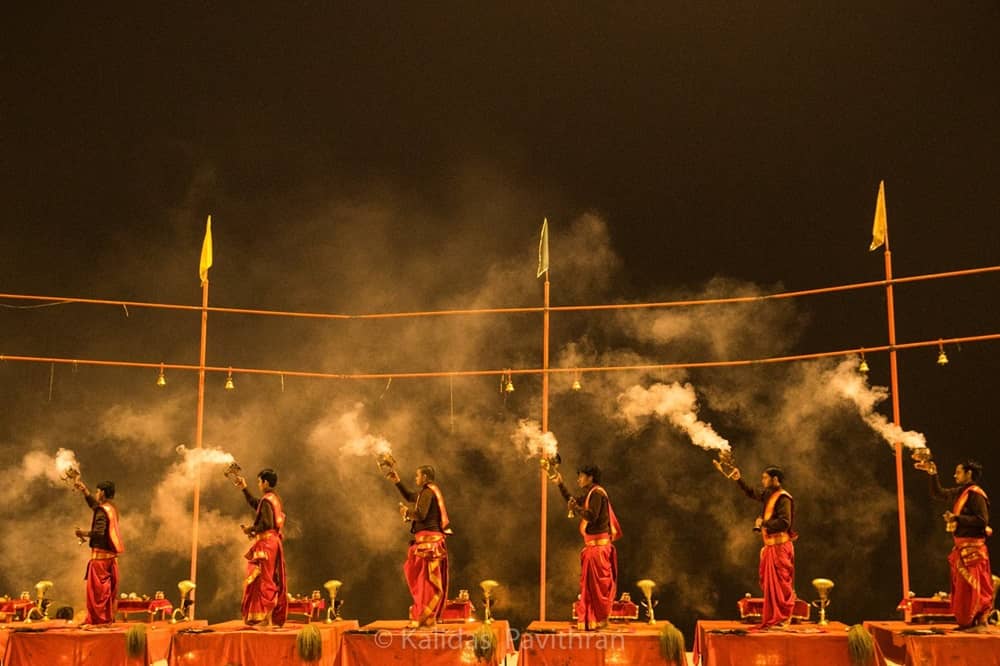
3. Assi Ghat – A Prime Spot for Viewing the Aarti (Except in Rainy Season):
- One of the best spots to witness the Ganga Aarti is Assi Ghat, a wide, open space that can accommodate many visitors. This makes it a great location if you prefer not to be too crowded during the ceremony.
- There are seating areas available, but if you prefer a more dynamic experience, I recommend walking around during the ceremony.
- This allows you to capture stunning photos from different angles, as Varanasi is a photographer’s paradise. Watching the Aarti from multiple perspectives can deepen your connection with the ritual and its significance.
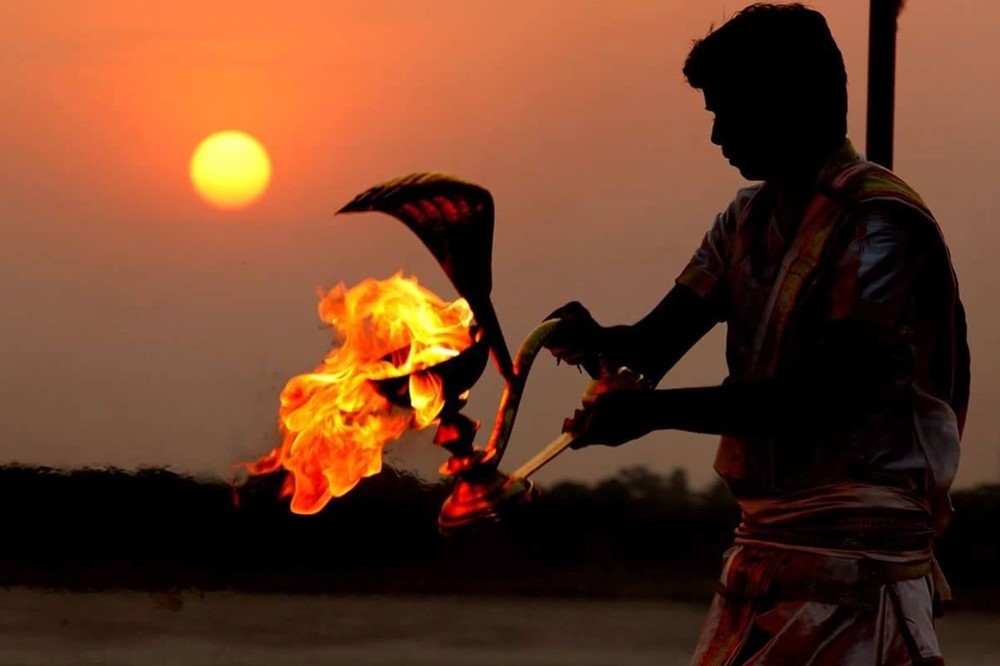
Evening Aarti at Dashashwamedh Ghat
- The Dashashwamedh Ghat is the epicenter of the grand evening Ganga Aarti.
- Performed by a group of priests, the ceremony features huge brass lamps filled with oil, their flames casting a golden glow over the river.
- The priests chant sacred mantras in unison, filling the air with powerful vibrations that stir the soul.
- Witnessing this spectacular ritual is a deeply spiritual experience, where the divine light seems to engulf the entire Ghat, spreading positivity and peace.
Morning Aarti at Assi Ghat
- Begin your day by witnessing the serene morning Aarti at Assi Ghat.
- As the sun rises, the river awakens to the devotional chants and the tranquil rituals performed with reverence by the priests.
- It’s a moment of calm, where the soft rays of dawn blend with the sacred atmosphere, creating a perfect harmony between nature and spirituality.
Ganga Aarti Varanasi Timing :
- Dashashwamedh Ghat Aarti Time: 6:45 PM to 07:30 PM (Summer)/ 5:45 PM to 06:30 PM (Winter)
- Aasi Ghat Aarti Time: Morning Aarti (Summer) – 5 AM/ Morning Aarti (Winter) – 05:30 AM and Evening Aarti (Summer) – 06:30 PM/ Evening Aarti (Winter) – 6 PM
Immerse Yourself in the Holy Ganges
This travel guide offers a chance to:
- Experience the spiritual grandeur of the Ganga Aarti rituals.
- Understand the significance of the Ganga and the sacred ceremonies associated with it.
- Take a holy dip in the Ganges, believed to purify the soul and wash away sins.
Whether it’s the vibrant evening ceremony at Dashashwamedh Ghat or the peaceful morning Aarti at Assi Ghat, the Ganga Aarti in Varanasi is a divine spectacle that touches the heart and uplifts the spirit.
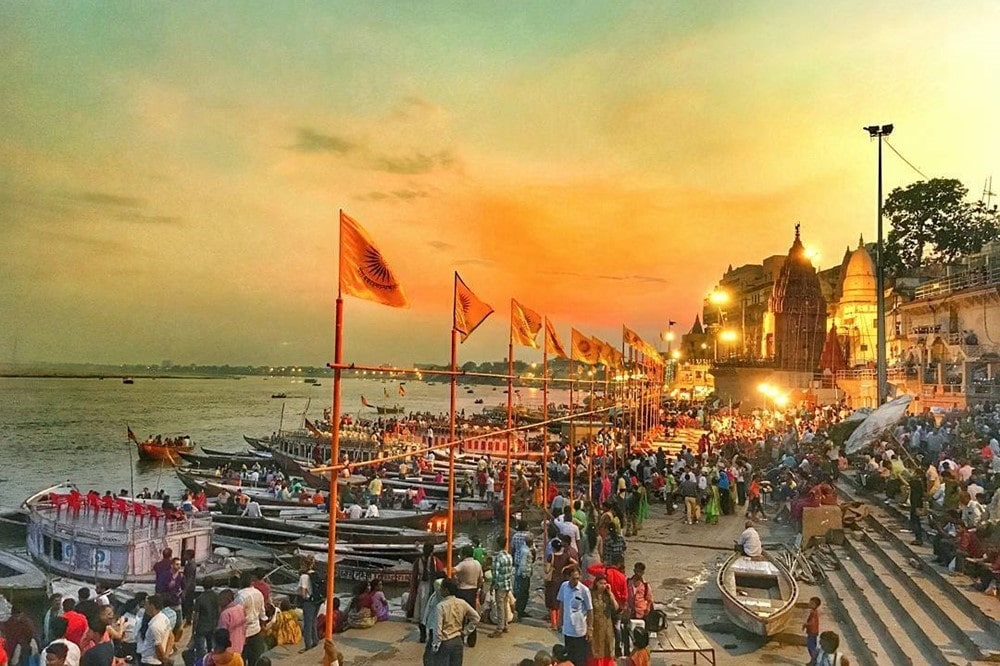
First Things First: Understanding the Ganga Aarti
Before attending the Ganga Aarti in Varanasi, it’s helpful to understand what this sacred ritual truly represents.
The Ganga Aarti is a nightly ceremony performed in three holy cities: Varanasi, Haridwar, and Rishikesh. This ritual is a way to honor the River Ganga, considered holy by Hindus and of immense religious significance.
According to Hindu legend, the Goddess Ganga descended to Earth and transformed into the sacred river. Devotees often bathe in its waters, believing that doing so will cleanse them of sins and offer spiritual renewal.
The Ganga Aarti ceremony begins with the blowing of a conch shell, believed to dispel negative energy and sharpen the senses. Following this, priests chant mantras and perform rituals using brass lamps, creating a captivating and divine atmosphere.
For devotees, attending the Aarti is more than a ritual—it is an act of faith. They believe that witnessing this ceremony will wash away their sins and bring peace to their ancestors’ souls.
The Ganga Aarti in Varanasi is a mesmerizing ritual that has drawn pilgrims and visitors to the sacred banks of the Holy Ganga River for centuries. Rooted in the worship of the Panch Tattvas—Earth, Sky, Fire, and Water—this grand tradition is a breathtaking homage to nature and spirituality, celebrated at various ghats across the city.
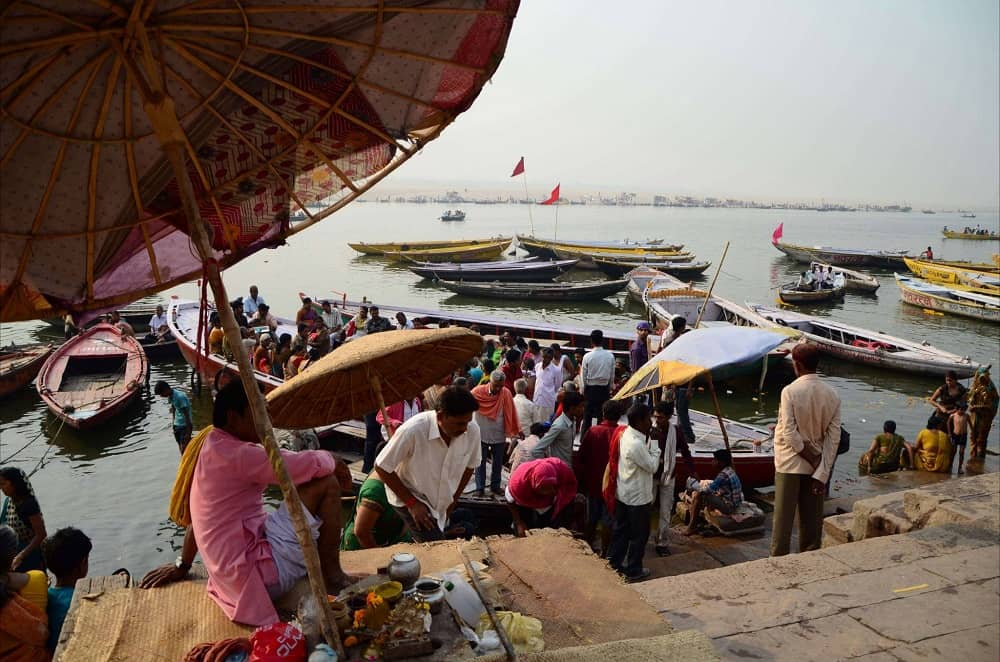
Key Highlights of the Varanasi Ganga Aarti
1. Subah-e-Banaras at Assi Ghat
- Morning Serenity: Begin your day with the tranquil Subah-e-Banaras at Assi Ghat, a spiritual spectacle marked by:
- Chanting of Vedic verses. Ganga Aarti Varanasi Timing
- A soul-stirring Ganga Aarti. Ganga Aarti Varanasi Timing
- Live performances of classical music and ragas.
- Unique Experience: Enjoy the serene Subah-e-Banaras Boat Ride for an unforgettable view of the river awakening under the first rays of the sun.
2. Evening Grandeur at Dashashwamedh Ghat
- The grand Varanasi Ganga Aarti at Dashashwamedh Ghat is a must-see event.
- Goddess Ganga’s statue placed centrally on an elevated platform.
- Priests perform synchronized rituals with lit diyas, incense sticks, and ringing bells, accompanied by the rhythmic chanting of mantras.
3. Aarti at Rajendra Prasad Ghat
- Another beautiful aarti performance can be witnessed here, providing a slightly less crowded yet equally divine experience.

Beyond Varanasi: A Legacy of Inspiration
- The grandeur of Varanasi’s Ganga Aarti has inspired similar rituals at other Hindu pilgrimage sites, including:
- Rishikesh and Haridwar in Uttarakhand. Ganga Aarti Varanasi Timing
- Ayodhya in Uttar Pradesh. Ganga Aarti Varanasi Timing
An Experience Steeped in Tradition
- The aarti ceremonies reflect the timeless traditions of Kashi, where every element is imbued with spiritual meaning. Whether at Subah-e-Banaras or the grand evening aarti at Dashashwamedh Ghat, the rituals are a profound celebration of devotion, unity, and the eternal bond between nature and spirituality.
Tips for Visiting Varanasi and Experiencing Ganga Aarti
To make the most of your trip to Varanasi and witness the breathtaking Ganga Aarti, here are some essential tips:
1. Choose the Right Ghats Ganga Aarti Varanasi Timing
- Dashashwamedh Ghat: Best for experiencing the grandeur of the evening Ganga Aarti.
- Assi Ghat: Ideal for the tranquil Subah-e-Banaras morning rituals and classical music performances.
2. Plan Your Arrival Time
Evening Aarti: Ganga Aarti Varanasi Timing
-
- Arrive at least an hour early to secure a good spot, as Dashashwamedh Ghat becomes very crowded quickly.
Morning Aarti: Ganga Aarti Varanasi Timing
-
- Less crowded, but attending the entire Subah-e-Banaras is highly recommended.
- Sleep early the night before to wake up refreshed and enjoy the serene experience.
3. Offerings and Costs Ganga Aarti Varanasi Timing
- Both aartis are free of cost, but there’s an option to make voluntary offerings during the evening Ganga Aarti.
- You can contribute any amount you feel comfortable with, though it is not mandatory.
4. Stay Safe and Alert Ganga Aarti Varanasi Timing
Crowded Areas: Dashashwamedh Ghat is particularly crowded; keep a close watch on your belongings. Avoid carrying valuables and use secure bags to prevent any mishaps.
5. Immerse Yourself Fully
- Witnessing the aartis isn’t just about observing; it’s about feeling the energy and spirituality of the moment.
- Allow yourself to soak in the sacred chants, the aroma of incense, and the light of the oil lamps.
The History of Ganga Aarti Varanasi
On their way home from school, a group of cheerful kids carrying colorful backpacks stops by the banks of the Holy Ganga, known for its power to cleanse a soul of all earthly sins. In the heart of the mystical city of Varanasi, they eagerly gather near the Dashashwamedh Ghat, a place steeped in stories and traditions.

Adjacent to the revered Kasi Vishwanath Temple, this iconic spot captures their imagination. Their teacher had told them that one Hindu legend speaks of Brahma, the creator, forming the ghat to welcome Lord Shiva, while another mentions Brahma performing the Ashwamedha Yajna ten times, giving the ghat its famous name. The children’s eyes light up with wonder as they discuss these stories, mixing their lessons with the magic of the sacred site.
Pooja Aesthetics:
Pundits, dressed in traditional dhoti and kurta, gather at the Dashashwamedh Ghat, where the sacred steps meet the holy Ganges. Each carries brass fire-lit earthen lamps, diyas, bells, incense sticks, and other ritualistic items, preparing for the ancient ceremony that has been performed for centuries.
Devotees from across the globe flock to witness this spiritual spectacle, with many opting for boat rides from the opposite bank of the Ganga River to capture a perfect view. At the heart of the ritual stands the priest from Gangotri Seva Samiti, one of the few renowned scholars of the Vedas and Upanishads, leading the aarti with grace and reverence.
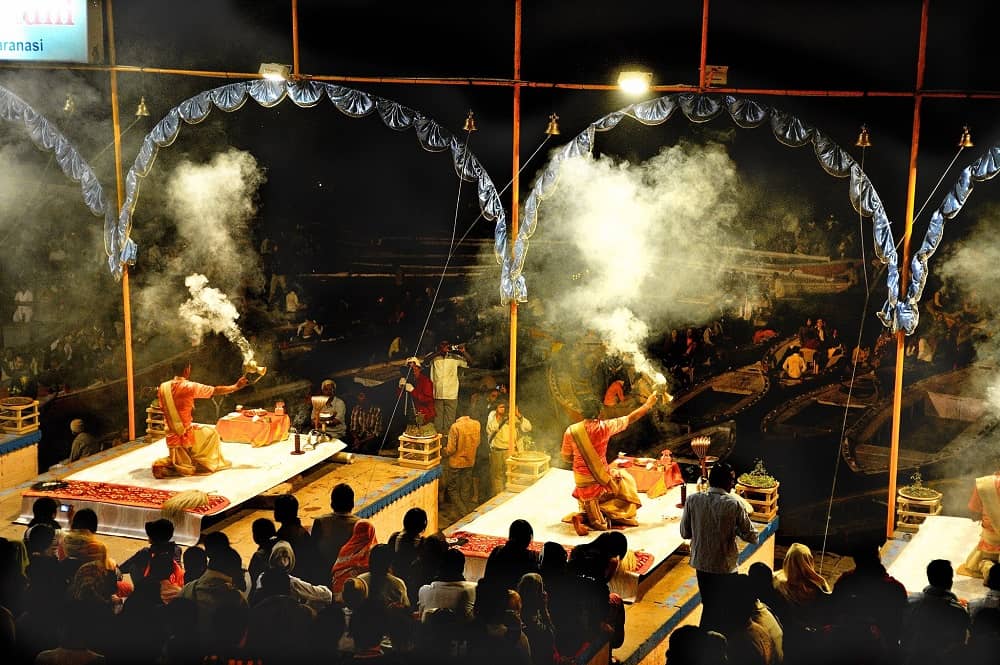
The atmosphere resonates with the chanting of holy mantras, their melody blending with the dramatic glow of multi-tiered diyas, the rhythmic ringing of bells, and the deep, resounding blow of conch shells. This grand symphony welcomes the deities in a manner akin to honoring a victorious hero returning from battle.
As the ceremony peaks, the Pundits perform the “maha aarti”, their movements synchronized with the chants and the rise of flames, creating a breathtaking spectacle. Devotees join the chorus, their voices merging with the pundits in prayer, as they seek blessings from the sacred Ganga for themselves and their
Spiritual Significance:
The Ganga Aarti ceremony is much more than a visual spectacle—it is a deeply spiritual experience. It symbolizes profound reverence for the holy Ganga, believed to have the divine power to wash away sins and bestow spiritual purity.
Attending this ceremony is considered a must for anyone seeking a deeper spiritual connection with the sacred city of Varanasi. The intensity and devotion displayed during the Aarti serve as a powerful reminder of the eternal bond between humanity and the divine.
Time to Visit Ganga Aarti Varanasi
The Ganga Aarthi is conducted twice daily, both in the morning and evening, offering devotees a chance to witness this sacred ritual.
Morning Ganga Aarti Timings Ganga Aarti Varanasi Timing
-
- Summer Timings: From 5:00 AM to 7:00 AM
- Winter Timings: From 5:30 AM to 7:30 AM
Evening Ganga Aarti Timings Ganga Aarti Varanasi Timing
-
- Summer Timings: Starts at 6:45 PM
- Winter Timings: Starts at 5:45 PM
Ganga Aarti Varanasi Timing Ganga Aarti Varanasi Timing Ganga Aarti Varanasi Timing Ganga Aarti Varanasi Timing Ganga Aarti Varanasi Timing
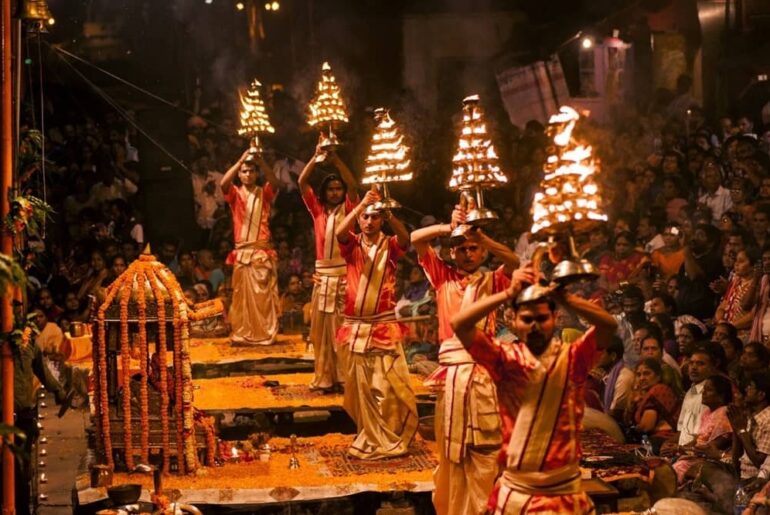
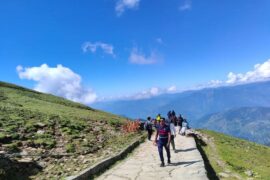

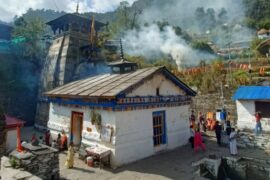
Comments are closed.